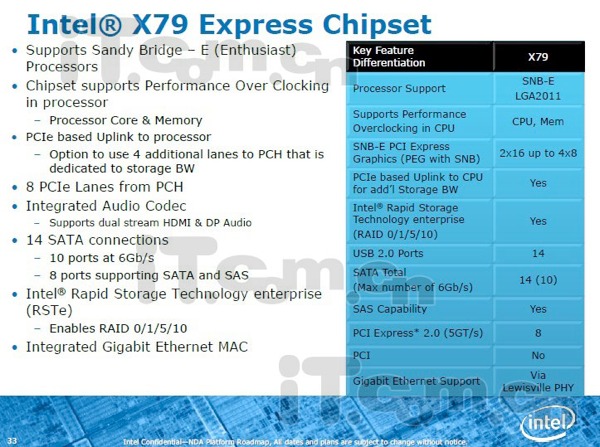Chinese site it.com.cn has managed to get their hands on an alleged Intel slide outlining the company's next platform for enthusiasts. According to the roadmap, the successor to the popular X58 platform carries the X79 moniker and will arrive in the final quarter of 2011 -- three years after the former's debut. The upcoming platform will seat four-core and six-core Sandy Bridge-E processors and bring several improvements in connectivity as well as memory bandwidth.
The platform will feature the LGA 2011 socket (yes, another one) and see the PCI-E hub moved from the northbridge to the processor die -- much like with the P67. The X79 chipset (or platform controller hub) also gets a DMI connection to the processor but supplements this with an additional PCI-Express 2.0 x4 link to the processor's PCI-E hub, for a total bandwidth of 8GB/s to support the integrated 10-port SATA 6Gbps controller plus four 3Gbps ports.

By comparison, current high-end 6-series chipsets only get two-port 6Gbps SATA beside four 3Gbps ports. Eight of the SATA 6Gbps ports can be set up as SAS (serial-attached SCSI), and RAID 0, 1, 5 and 10 are also supported. There's no talk of an integrated USB 3.0 controller or Thunderbolt for that matter, but the PCH still features 14 USB 2.0 ports.
Boards based on the X79 will allow for two PCI-Express x16 @ x16 or four PCIe x16 @ x8 slots and are set to have at least four DDR3 slots since Sandy Bridge E CPUs work with quad-channel memory. Other features include an integrated Lewisville gigabit Ethernet PHY chip and audio codec with support for dual stream HDMI and DP audio. Lastly, the slides mention overclocking capabilities for the processor and memory, which is expected for this enthusiast platform.